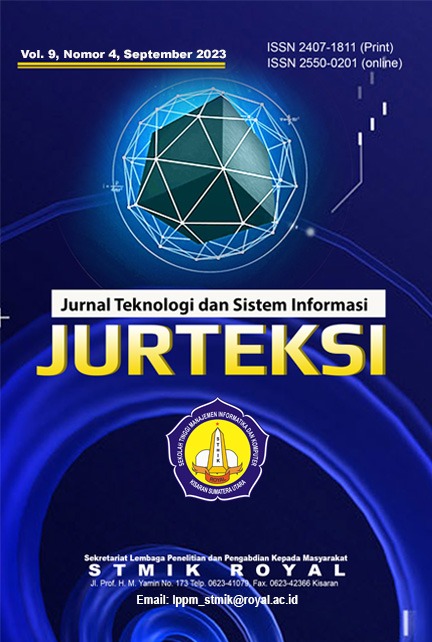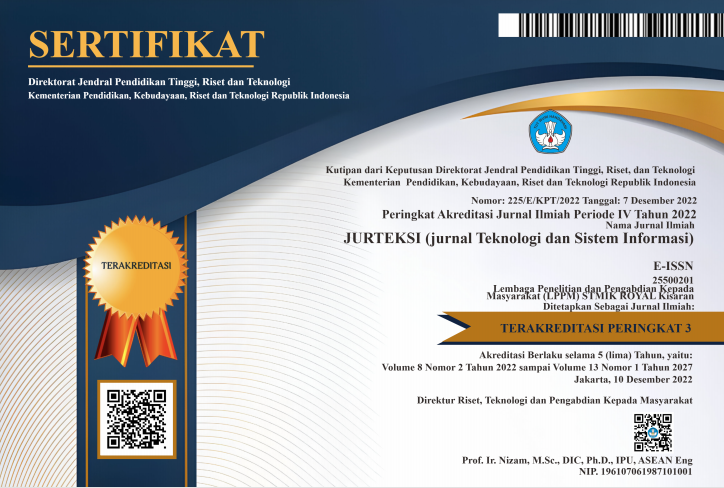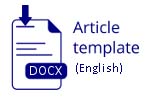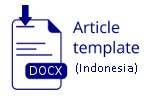ARCHITECTURAL DESIGN OF BAKUNJANGAN TOURISM APPLICATION IN BANJARMASIN CITY USING ZACHMAN FRAMEWORK
Abstract
Abstract: The implementation of Enterprise Architecture (EA) in Banjarmasin city's tourism sector is essential to improve the effectiveness of information provided to tourists accessing electronic-based services. Unfortunately, there are some crucial challenges to the fundamental requirements of EA in the tourism sector. There is still partial implementation, a lack of understanding of the technological advances used in Banjarmasin city tourism promotion, a lack of understanding of the implementation in an application architecture framework design and the technology to be used, not having good documentation in the design of application systems and slow services in tourism promotion. There is no certainty of normative standardization for system development operating procedures. This research aims to design the Zachman Framework (ZF) Application architecture as an Enterprise Architecture Planning (EAP) methodology, to visualize spatial data. This application is designed to assist users in displaying spatial data in the form of interactive maps that can be accessed via the internet. The software development method used is the iterative and incremental method with the Zachman Framework approach to application design. Data was collected through surveys and interviews at the Department of Culture, Youth, Sports and Tourism (DISBUDPORAPAR) of Banjarmasin City, with the current number of tourism data being 55 tourist attractions. This application can later be used to introduce tourist attractions in Banjarmasin City to the wider community, including tourists visiting this city.
Keywords: enterprise architecture (ea), tourism, zachman framework (zf)
Abstrak: Penerapan Enterprise Architecture (EA) disektor pariwisata kota Banjarmasin amatlah penting untuk meningkatkan efektivitas informasi yang diberikan kepada wisatawan yang mengakses layanan berbasis elektronik. Sayangnya, ada beberapa tantangan krusial terhadap persyaratan mendasar EA di sektor pariwisata. Masih ada yang diimplitasikan seara parsial, kurangnya pemahaman dalam kemajuan teknologi yang digunakan pada promosi pariwisata kota Banjarmasin, kurangnya pemahaman akan implimentasi dalam sebuat perancangan kerangka kerja arsitektur aplikasi dan teknologi yang akan digunakan, tidak memiliki dokumentsai yang baik dalam perancangan sistem aplikasi serta pelayanan yang lambat dalam promosi pariwisata. Belum adanya kepastian standarisasi normatif untuk prosedur operasi pengembangan sistem. Penelitian ini bertujuan untuk merancang arsitektur Aplikasi Bakunjangan Zachman Framework (ZF) sebagai metodologi Enterprise Architecture Planning (EAP), untuk memvisualisasikan data spasial. Aplikasi ini dirancang untuk membantu pengguna dalam menampilkan data spasial dalam bentuk peta interaktif yang dapat diakses melalui internet. Metode pengembangan perangkat lunak yang digunakan adalah metode iteratif dan inkremental dengan pendekatan Zachman Framework untuk perancangan aplikasi. Data dikumpulkan melalui survey dan wawancara pada Dinas Kebudayaan, Kepemudaan, Olahraga dan Pariwisata (DISBUDPORAPAR) Kota Banjarmasin, dengan jumlah data pariwisata saat ini yakni 55 tempat wisata. Aplikasi ini nanti dapat digunakan untuk memperkenalkan objek wisata di Kota Banjarmasin kepada masyarakat luas, termasuk wisatawan yang berkunjung ke kota ini.
Kata kunci: enterprise architecture (ea), pariwisata, zachman framework (zf)
References
J. F. Andry, L. Liliana, and A. Chakir, “Enterprise Architecture Landscape using Zachman Framework and Ward Peppard Analysis for Electrical Equipment Export Import Company,†Trends in Sciences, vol. 18, no. 19, p. 23, Oct. 2021, doi: 10.48048/tis.2021.23.
A. K. Darmawan, F. Masykur, M. Muhsi, B. A. Umam, and R. Rofiuddin, “Proposing Enterprise Architecture for Smart Regencies in Indonesia: A Perspective of Zachman Framework (ZF),†in 2022 International Conference on ICT for Smart Society (ICISS), IEEE, Aug. 2022, pp. 1–7. doi: 10.1109/ICISS55894.2022.9915118.
N. Wayan Rena Mariani, I. Made Sudjana, and M. Arya Astina, “PEMANFAATAN ZACHMAN FRAMEWORK DALAM PENGEMBANGAN BLUEPRINT SISTEM INFORMASI LEMBAGA SERTIFIKASI USAHA PARIWISATA,†SIBATIK JOURNAL: Jurnal Ilmiah Bidang Sosial, Ekonomi, Budaya, Teknologi, dan Pendidikan, vol. 2, no. 2, pp. 637–650, Jan. 2023, doi: 10.54443/sibatik.v2i2.635.
E. Kornyshova and R. Deneckère, “A Proposal of a Situational Approach for Enterprise Architecture Frameworks: Application to TOGAF,†Procedia Comput Sci, vol. 207, pp. 3499–3506, 2022, doi: 10.1016/j.procs.2022.09.408.
M-Hidayat, “PERANCANGAN ARSITEKTUR SISTEM INFORMASI PENGELOLAAN KRISIS KESEHATAN MENGGUNAKAN ZACHMAN FRAMEWORK,†Jurnal Informatika Polinema, vol. 8, no. 4, pp. 17–24, Aug. 2022, doi: 10.33795/jip.v8i4.971.
M. Muslih et al., “Implementation of Impact Zachman Framework on Internship Architecture Data Management,†in 2020 6th International Conference on Computing Engineering and Design (ICCED), IEEE, Oct. 2020, pp. 1–6. doi: 10.1109/ICCED51276.2020.9415777.
John A. Zachman, “The Zachman Framework For Enterprise Architecture, Primer for Enterprise Engineering and Manufacturing,†CA Mag, vol. 128, no. 9, p. 15, 2003.
M. Hidayat, “Penyusunan Rencana Strategis Sistem Informasi STKIP PGRI Banjarmasin Menggunakan Enterprise Architecture Planning,†Jurnal Teknologi Rekayasa, vol. 2, no. 2, p. 63, Feb. 2018, doi: 10.31544/jtera.v2.i2.2017.63-72.
I. N. Farida, A. Rosidi, and S. A. Syahdan, “Perencanaan Enterprise Architecture di Rumah Sakit Umum Muhammadiyah Surya Melati Kediri,†Creative Information Technology Journal, vol. 1, no. 1, p. 25, Apr. 2015, doi: 10.24076/citec.2013v1i1.7.
B. Anthony Jnr, S. Abbas Petersen, M. Helfert, and H. Guo, “Digital transformation with enterprise architecture for smarter cities: a qualitative research approach,†Digital Policy, Regulation and Governance, vol. 23, no. 4, pp. 355–376, Oct. 2021, doi: 10.1108/DPRG-04-2020-0044.
Hilmi Aulawi and Leni Fitriani, “Enterprise Architecture Planning for E-Government,†International Journal of Innovation, Creativity and Change (IJICC), vol. 11, no. 2, pp. 215–270, 2020.
M. Thirasakthana and S. Kiattisin, “Sustainable Government Enterprise Architecture Framework,†Sustainability, vol. 13, no. 2, p. 879, Jan. 2021, doi: 10.3390/su13020879.
A. Setiawan and E. Yulianto, “E-Government Interoperability and Integration Architecture Modeling Using TOGAF Framework Based On Service Oriented Architecture,†The Asian Journal of Technology Management (AJTM), vol. 11, no. 1, pp. 26–43, 2018, doi: 10.12695/ajtm.2018.11.3.
S. Kotusev, “Enterprise architecture and enterprise architecture artifacts: Questioning the old concept in light of new findings,†Journal of Information Technology, vol. 34, no. 2, pp. 102–128, Jun. 2019, doi: 10.1177/0268396218816273.
J. F. Sowa and J. A. Zachman, “Extending and formalizing the framework for information systems architecture,†IBM Systems Journal, vol. 31, no. 3, pp. 590–616, 1992, doi: 10.1147/sj.313.0590.
Y. H. Maur and A. W. R. Emanuel, “Perencanaan Arsitektur Teknologi Informasi Kelurahan Babau Menggunakan TOGAF ADM,†Jurnal Buana Informatika, vol. 12, no. 2, pp. 116–125, Nov. 2021, doi: 10.24002/jbi.v12i2.4660.
Dr. S. Suriya and N. S., “Design of UML Diagrams for WEBMED - Healthcare Service System Services,†EAI Endorsed Transactions on e-Learning, vol. 8, no. 1, p. e5, Feb. 2023, doi: 10.4108/eetel.v8i1.3015.













